2023 Reports 6 to 10 of the Commissioner of the Environment and Sustainable Development to the Parliament of Canada
Report 6—Canadian Net-Zero Emissions Accountability Act—2030 Emissions Reduction Plan
At a Glance
The federal government is not on track to meet the 2030 target to reduce greenhouse gas emissions by at least 40% below the 2005 level by 2030. While the 2030 Emissions Reduction Plan included important mitigation measures to reduce emissions, some of these measures, such as the Oil and Gas Emissions Cap and the Clean Fuel Regulations, have been delayed. We found that the measures most critical for reducing emissions had not been identified or prioritized.
These are not new findings. The federal government has failed to meet previous emission reduction targets despite the development and implementation of more than 10 climate change mitigation plans since 1990. Canada’s current emissions are significantly higher than they were in 1990. Environment and Climate Change Canada had still not taken sufficient steps to improve the transparency and reliability of its economic and emission modelling despite repeated recommendations from our office and modelling experts. Course correction is critical to achieving the target. However, we found that responsibility for reducing emissions was fragmented among multiple federal organizations that were not directly accountable to the Minister of Environment and Climate Change. This means there is no real way for the minister to commit other federal organizations to correcting course to meet the 2030 targets.
While some progress has been made, we are still extremely concerned about the federal government’s ability to achieve meaningful progress under the new Canadian Net‑Zero Emissions Accountability Act. The stakes for failing to mitigate climate change grow ever higher, and the window of opportunity to reduce emissions and meet the 2030 and 2050 targets is rapidly closing.
Key facts and findings
- In March 2022, the Minister of Environment and Climate Change published the 2030 Emissions Reduction Plan, the first plan under the Canadian Net‑Zero Emissions Accountability Act.
- The act requires the Commissioner of the Environment and Sustainable Development to report by the end of 2024 on the implementation of the measures aimed at mitigating climate change. With the urgent need for rapid, deep emission cuts in Canada’s fight against catastrophic climate change, we decided to begin reporting in fall 2023, more than a year earlier than required.
- In the 2030 plan, Environment and Climate Change Canada and Natural Resources Canada made efforts to identify groups that could be disproportionately burdened by measures in the plan and developed some measures to support them.
- Environment and Climate Change Canada projected that Canada would miss the target for reducing emissions. To meet the 2030 target, emissions should be reduced by at least 40% below the 2005 level. In December 2022, the department revised the emission reductions it expected from the 2030 plan from achieving 36.4% below the 2005 level to 34%, missing the 2030 target by an even wider margin.
- Only 45% of the measures in the plan had an implementation deadline.
- The plan did not include a target or expected emission reductions for 95% of its measures. Federal government organizations expected only 43% of measures to have some direct impact on emissions.
- Weaknesses in Environment and Climate Change Canada’s economic modelling included overly optimistic assumptions, limited analysis of uncertainties, and lack of peer review.
- The act does not require the minister to achieve the targets. If Canada were to fail again in meeting its target, the act only requires that the minister include the reasons why and propose actions to address the failure.
Why we did this audit
- The audit will help Parliament hold the government to account for its plans and progress toward its greenhouse gas emission reduction target and for its commitments to Canadians and the international community.
- The audit serves as a benchmark for measuring success now and in the future.
- As the first plan under the Canadian Net‑Zero Emissions Accountability Act, the 2030 Emissions Reduction Plan represents an opportunity to set out how to meet Canada’s target for reducing emissions to 40% to 45% below the 2005 level by 2030.
- Timely and effective implementation of the mitigation measures is essential for the 2030 Emissions Reduction Plan to succeed.
- It is essential for federal organizations to know whether they are on course toward the 2030 emission reduction target and to correct their course if they are not.
Highlights of our recommendations
- To improve transparency and effectiveness in implementing measures, Environment and Climate Change Canada should publish timetables specifying an implementation deadline, milestones, and expected emission reductions for each of its measures.
- To ensure that the next Emissions Reduction Plan is inclusive, Environment and Climate Change Canada, working with the federal organizations implementing measures in the plan, should conduct a thorough analysis on all measures within the plan to determine how certain groups will be affected by the plan and its measures.
- To improve the transparency and credibility of its modelling, Environment and Climate Change Canada should work with independent scientists, engineers, and economists and apply their expertise in a pan‑Canadian modelling forum.
- To support timely course correction, Environment and Climate Change Canada, working with federal organizations including Statistics Canada, should develop methods for estimating greenhouse gas emission data with a lag of no more than a year and ideally less.
Please see the full report to read our complete findings, analysis, recommendations and the audited organizations’ responses.
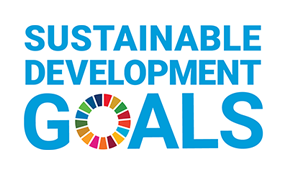

Canada based its Federal Sustainable Development Strategy on the United Nations’ goals and the 2030 Emission plan supports the United Nations’ Sustainable Development Goal 13 (Climate Action).
Visit our Sustainable Development page to learn more about sustainable development and the Office of the Auditor General of CanadaOAG.
Exhibit highlights
Timeline of target setting, deadlines, and reports as required under the Canadian Net‑Zero Emissions Accountability Act
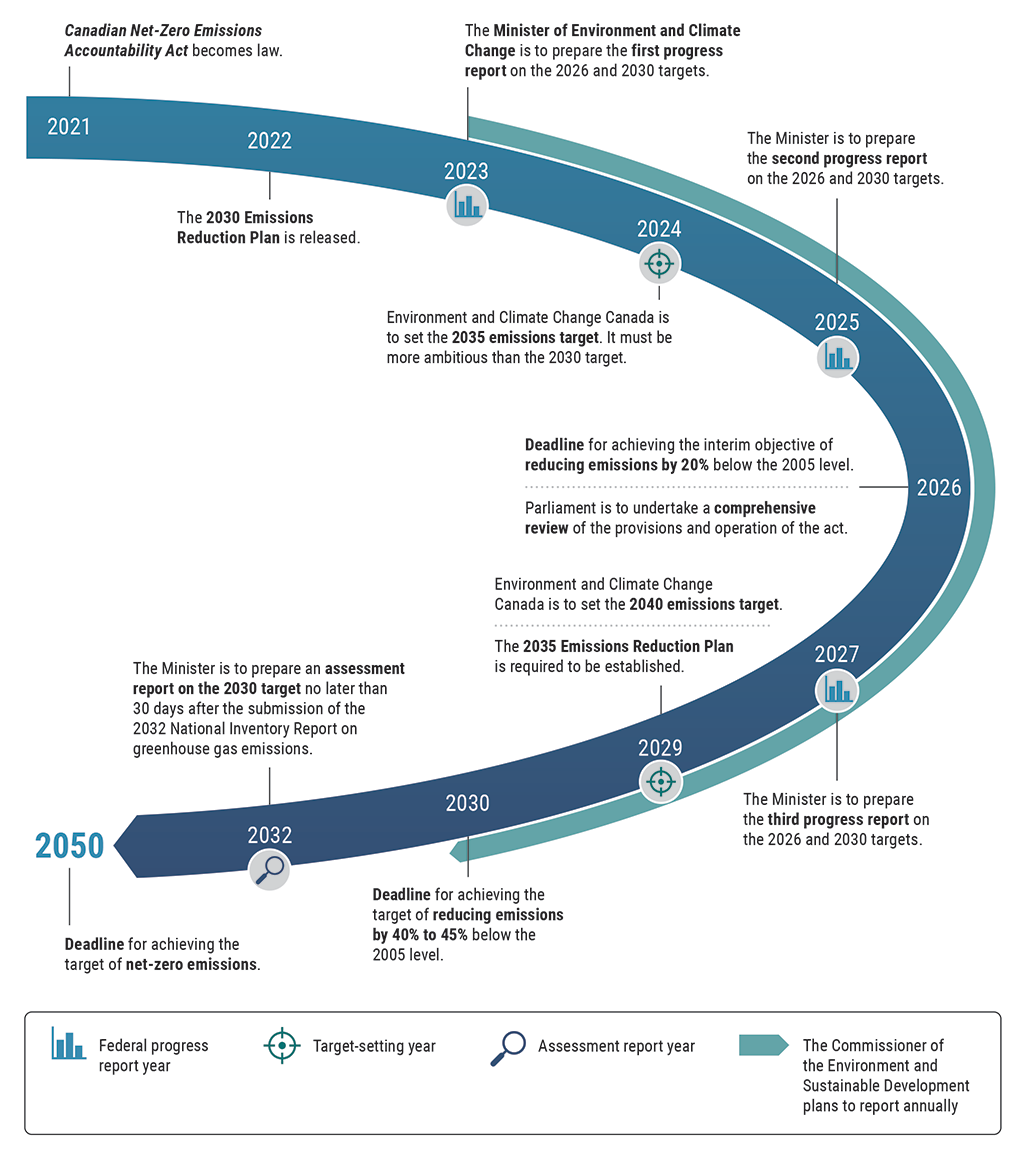
Source: Canadian Net‑Zero Emissions Accountability Act
Text version
This timeline shows the years from 2021 to 2050 and when federal progress reports, targets, deadlines, and assessment reports are required under the Canadian Net‑Zero Emissions Accountability Act. The timeline also shows that the Commissioner of the Environment plans toreport annually.
In 2021, the Canadian Net‑Zero Emissions Accountability Act becomes law.
In 2022, the 2030 Emissions Reduction Plan is released.
In 2023, the Minister of Environment and Climate Change is to prepare the first progress report on the 2026 and 2030 targets.
In 2024, Environment and Climate Change Canada is to set the 2035 emissions target. It must be more ambitious than the 2030 target.
In 2025, the minister is to prepare the second progress report on the 2026 and 2030 targets.
In 2026 is the deadline for achieving the interim objective of reducing emissions by 20% below the 2005 level. Also, Parliament is to undertake a comprehensive review of the provisions and operation of the act.
In 2027, the minister is to prepare the third progress report on the 2026 and 2030 targets.
In 2029, Environment and Climate Change Canada is to set the 2040 emissions target. Also, the 2035 Emissions Reduction Plan is required to be established.
In 2030 is the deadline for achieving the target of reducing emissions by 40% to 45% below the 2005 level.
In 2032, the minister is to prepare an assessment report on the 2030 target no later than 30 days after the submission of the 2032 National Inventory Report on greenhouse gas emissions.
In 2050 is the deadline for achieving the target of net‑zero emissions.
Canada’s performance in reducing greenhouse gas emissions and the years it issued plans to reduce emissions
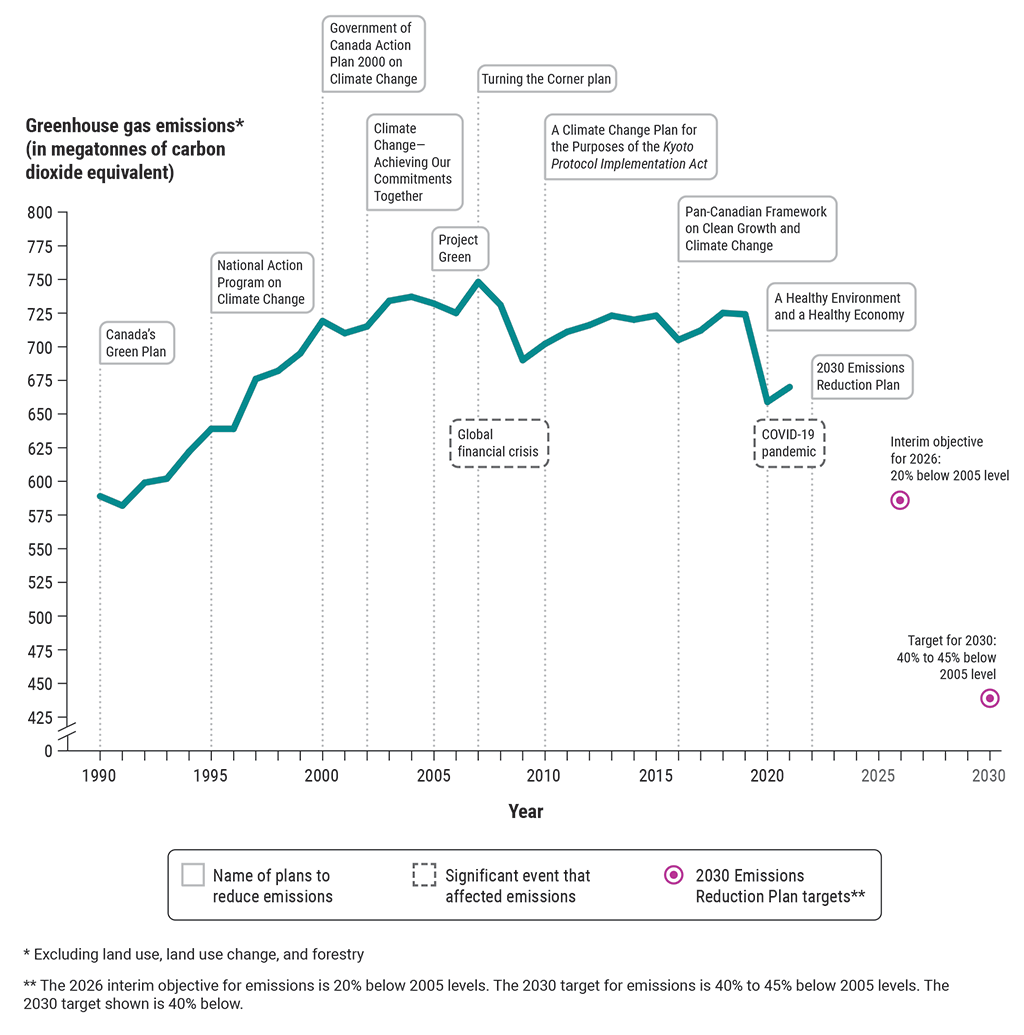
Source: Based on data from the National Inventory Report 1990–2021: Greenhouse Gas Sources and Sinks in Canada, Environment and Climate Change Canada, 2023
Text version
This chart shows Canada’s greenhouse gas emissions from 1990 to 2021, the years when plans for reducing emissions were issued, significant events that affected emissions, and the targets in the 2030 Emissions Reduction Plan. The emissions shown exclude land use, land use change, and forestry. Overall, in 2021, Canada’s greenhouse gas emissions were higher than in 1990.
In 1990, Canada’s greenhouse gas emissions were 589 megatonnes of carbon dioxide equivalent, and Canada’s Green Plan was issued.
In 1995, Canada’s greenhouse gas emissions were 639 megatonnes of carbon dioxide equivalent, and the National Action Program on Climate Change was issued.
In 2000, Canada’s greenhouse gas emissions were 719 megatonnes of carbon dioxide equivalent, and the Government of Canada Action Plan 2000 on Climate Change was issued.
In 2002, Canada’s greenhouse gas emissions were 715 megatonnes of carbon dioxide equivalent, and Climate Change—Achieving Our Commitments Together was issued.
In 2005, Canada’s greenhouse gas emissions were 732 megatonnes of carbon dioxide equivalent, and Project Green was issued.
From 2006 to 2010, the global financial crisis was a significant event that affected emissions.
In 2007, Canada’s greenhouse gas emissions were 748 megatonnes of carbon dioxide equivalent, and Turning the Corner plan was issued.
In 2010, Canada’s greenhouse gas emissions were 702 megatonnes of carbon dioxide equivalent, and A Climate Change Plan for the Purposes of the Kyoto Protocol Implementation Act was issued.
In 2016, Canada’s greenhouse gas emissions were 705 megatonnes of carbon dioxide equivalent, and the Pan-Canadian Framework on Clean Growth and Climate Change was issued.
From 2020 to 2022, the COVID‑19 pandemic affected emissions.
In 2020, Canada’s greenhouse gas emissions were 659 megatonnes of carbon dioxide equivalent, and A Healthy Environment and a Healthy Economy was issued.
In 2021, Canada’s greenhouse gas emissions were 670 megatonnes of carbon dioxide equivalent.
In 2022, the 2030 Emissions Reduction Plan was issued.
The 2026 interim objective for emissions is 586 megatonnes of carbon dioxide equivalent, which is 20% below the 2005 level. The 2026 interim objective is from the 2030 Emissions Reduction Plan.
The 2030 target for emissions is 40% to 45% below the 2005 level. The 2030 target shown is 439 megatonnes of carbon dioxide equivalent, which is 40% below the 2005 level. The 2030 target shown is 40% below. The 2030 target is from the 2030 Emissions Reduction Plan.
Nearly half of the 80 emission reduction measures in the 2030 Emissions Reduction Plan did not have a deadline for achievement
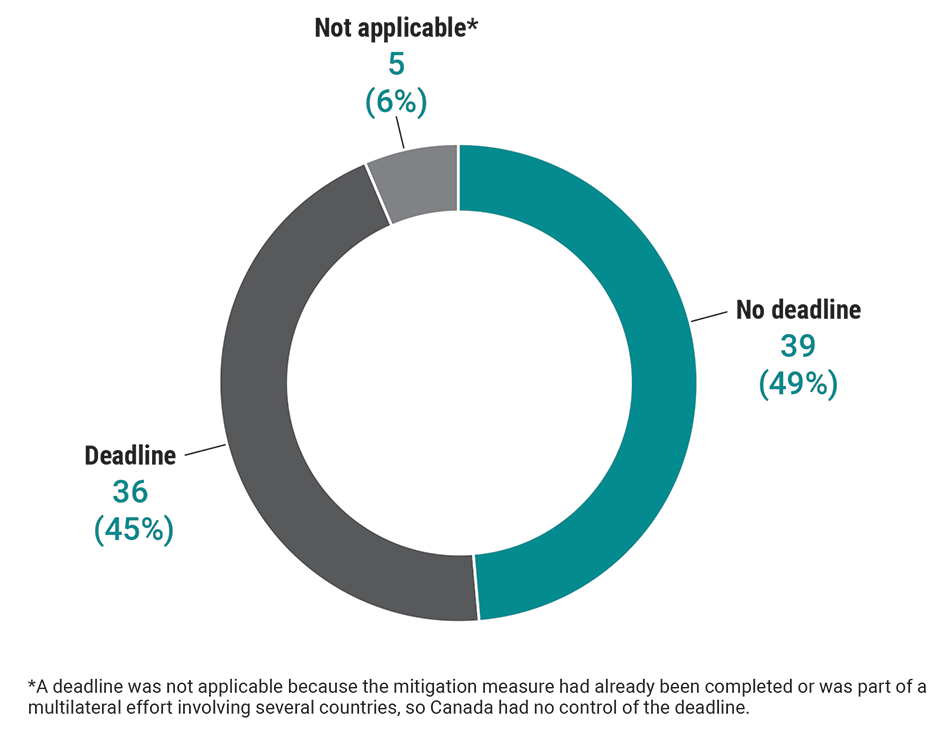
Source: Based on information in the 2030 Emissions Reduction Plan, Environment and Climate Change Canada, 2022
Text version
This chart breaks down the 80 measures into 3 categories and shows the number and percentage for each category. The 3 categories are as follows:
- the measures with a deadline
- the measures with no deadline
- the measures for which a deadline was not applicable because the mitigation measure had already been completed or was part of a multilateral effort involving several countries, so Canada had no control of the deadline
Overall, the greatest number of measures had no deadline: 39 (or 49%) of the 80 measures had no deadline.
The number of measures with a deadline was 36 (or 45%) of the 80 measures.
A deadline was not applicable for 5 (or 6%) of the 80 measures.
The oil and gas sector continued to be the highest-emitting economic sector in Canada in 2021
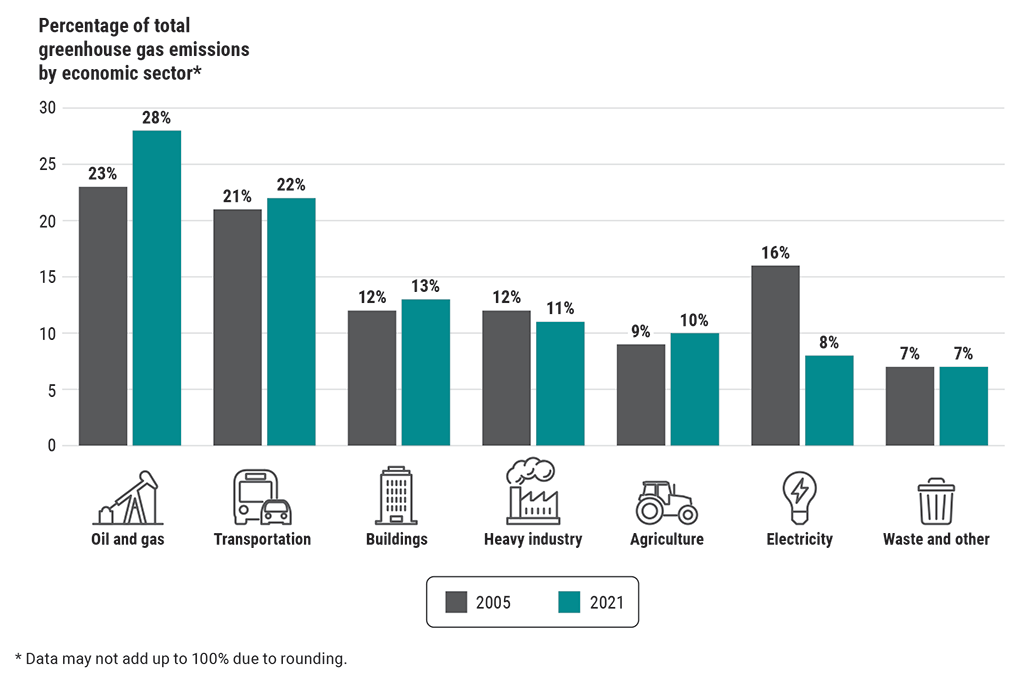
Source: National Inventory Report 1990–2021: Greenhouse Gas Sources and Sinks in Canada, Environment and Climate Change Canada, 2023
Text version
This chart shows the percentage of total greenhouse gas emissions in 2005 and in 2021 for 7 economic sectors. For either 2005 or 2021, data may not add up to 100% due to rounding. Overall, the oil and gas sector had the highest percentage of greenhouse gas emissions.
In 2005, the oil and gas sector accounted for 23% of the total greenhouse gas emissions. In 2021, the percentage of emissions for this sector increased to 28%.
In 2005, the transportation sector accounted for 21% of the total greenhouse gas emissions. In 2021, the percentage of emissions for this sector increased to 22%.
In 2005, the buildings sector accounted for 12% of the total greenhouse gas emissions. In 2021, the percentage of emissions for this sector increased to 13%.
In 2005, the heavy industry sector accounted for 12% of the total greenhouse gas emissions. In 2021, the percentage of emissions for this sector decreased to 11%.
In 2005, the agriculture sector accounted for 9% of the total greenhouse gas emissions. In 2021, the percentage of emissions for this sector increased to 10%.
In 2005, the electricity sector accounted for 16% of the total greenhouse gas emissions. In 2021, the percentage of emissions for this sector decreased to 8%.
In 2005, the waste and other sector accounted for 7% of the total greenhouse gas emissions. In 2021, the percentage of emissions for this sector remained at 7%.
Infographic

Text version
Canadian Net-Zero Emissions Accountability Act—2030 Emissions Reduction Plan
Despite more than 10 government plans since 1990 to reduce greenhouse gas emissions, Canada’s emissions were higher in 2021 than in 1990.
What is the Canadian Net-Zero Emissions Accountability Act?
A tool to promote transparency and accountability in the federal government’s efforts to ensure Canada achieves net‑zero greenhouse gas emissions by 2050.
The act requires that the Minister of Environment and Climate Change sets emission targets and prepares emissions reduction plans and progress reports.
In March 2022, the Minister of Environment and Climate Change published the first 2030 Emissions Reduction Plan.
The act also requires that the Commissioner of the Environment and Sustainable Development reports on the government’s implementation of measures to reduce greenhouse gas emissions.
The first report by the Commissioner of the Environment and Sustainable Development was tabled in November 2023.
The 2030 Emissions Reduction Plan is insufficient to meet the target to reduce emissions by 40% to 45% below the 2005 level.
The 2005 emission level is the baseline.
The 2030 plan projected a 34% reduction in emissions compared with the 2005 level.
The 2030 target is a 40% to 45% reduction in emissions compared with the 2005 level.
Key findings
- In the 2030 plan, 95% of the measures did not have a reduction target.
- The strongest measures for reducing emissions were not identified or prioritized.
- Accountability for reducing emissions was fragmented among multiple federal entities.
- Potentially strong measures were delayed.
We are extremely concerned about the federal government’s ability to achieve meaningful progress under the new Canadian Net‑Zero Emissions Accountability Act.
The stakes for failing to mitigate climate change grow ever higher, and the window of opportunity to reduce emissions and meet the 2030 and 2050 targets is rapidly closing.
Related information
Entities
Tabling date
- 7 November 2023
Related audits
- 2023 Reports 1 to 5 of the Commissioner of the Environment and Sustainable Development
Report 5—Emission Reductions Through Greenhouse Gas Regulations—Environment and Climate Change Canada - 2022 Reports 1 to 5 of the Commissioner of the Environment and Sustainable Development
Report 5—Carbon Pricing—Environment and Climate Change Canada - 2021 Reports 3 to 7 of the Commissioner of the Environment and Sustainable Development
Report 5—Lessons Learned from Canada’s Record on Climate Change
Parliamentary hearings
